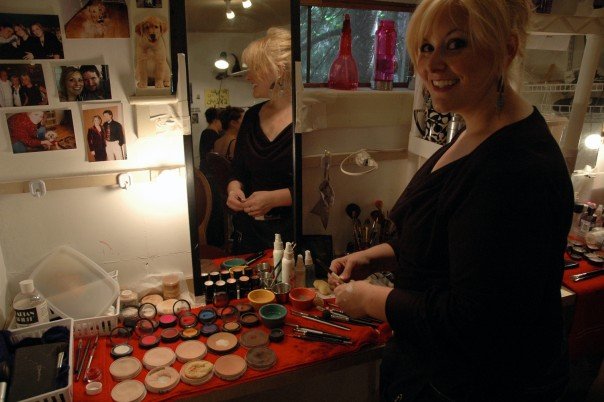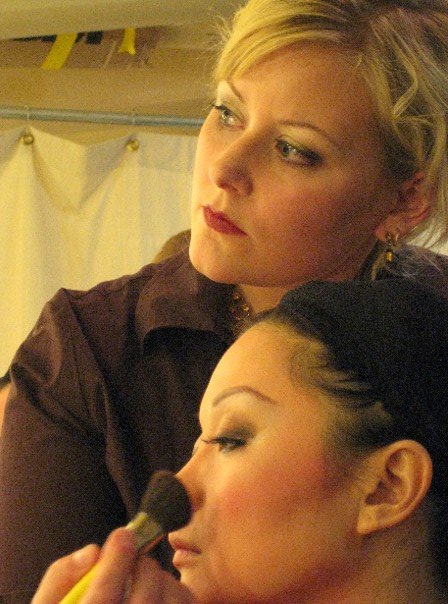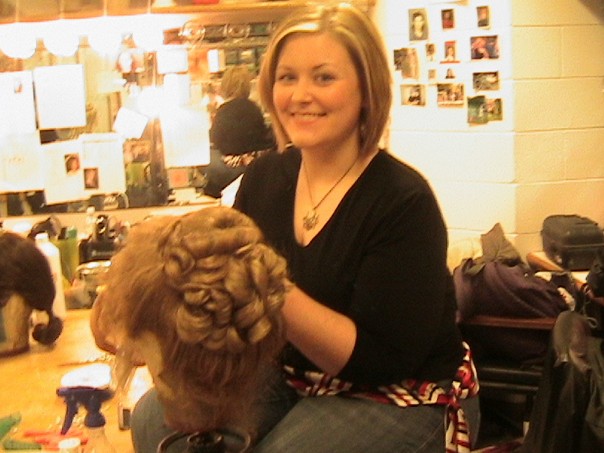April 22, 2019
An Interview with Wigmaster and Makeup Designer Sarah Hatten
Sarah Hatten is the Marlys Beider Wigmaster and Makeup Designer Endowed Chair for Lyric Opera of Chicago. 2019/20 will be Sarah’s 9th season at Lyric, and she has shared with us defining moments in her career, Lyric memories, and what it takes to work in wigs and makeup!
Where are you from originally?
I am from Iowa and grew up in the small town of Fort Dodge. I went to school at Simpson College, which is south of Des Moines... their claim to fame is Des Moines Metropolitan Opera.
How did you become interested in wigs/hair and makeup? Did you go into school knowing you wanted to do behind the scenes?
Well, I started school as a vocal performance major. I had done a lot of community theater and worked backstage, and like many small programs you have to help backstage, so I would assist with handling and preparing props. The summer after my first year at Simpson, I was a props artisan at Des Moines Metropolitan Opera. At Des Moines, I met Joanne Weaver, who introduced me to the idea that hair and makeup design could be a career. I had a lot of interest in doing hair and makeup, and like many students I was frustrated in the progress my voice was making and a singing career. So, I then took an internship with Sarasota Opera and continued to work for Joanne Weaver there. This career clicked right away for me, and while I finished my degree, I switched from a Bachelor of Music to a Bachelor of Art with a music focus, and I started working in hair and makeup right after school, with very heavy focuses and most of my work in opera.

What kind of training is involved for someone in wigs/hair and makeup?
For me, I learned on the job. I didn’t go to cosmetology school, I just worked my way from the bottom to the top, and there’s so much that you can’t learn in a school or class setting. Like any job or trade, there are instances to the rule that are going to bend and unique things you can’t prepare for. Our department is comprised of a mix of skills: some are licensed cosmetologists, some make-up artists, and we teach them how to put wigs on. To work in the shop, it does require the skill of being able to build wigs and style them, but hair cutting and color requires licensed training. In terms of running a show start to finish, you don’t need licenses as much as you need experience. I would recommend for anyone looking to get into the business to get your degree if that’s what you are interested in, but even more so, gain experience - especially when you’re young - volunteer at theaters and take internships. That being said, there are schools that have theater degrees with specialties in hair and makeup design. It’s really very mixed and depends on what you want.
Doing hair and makeup gives a different viewpoint - regionally, you work more with the singers, living with them and working with them, and it’s more intimate. As a former performance singer, I understand the anxiety of singing on stage and am able to be sensitive to a singer’s needs before they head on stage, and of course, everyone has a different process. Generally speaking, you’re among the first people that a singer sees when they come off stage, along with the dresser...whatever is happening onstage with the singer, you’re the first person to come in contact with that - you learn to go with the flow and keep the show going. When hiring crew members that is almost more important than their skill set. You can learn what goes on with a show but you can’t teach personality.
When did you begin at Lyric? First show?
My first season was 2011/12, and the first show that season was The Tales of Hoffman. I remember that season was giant, it was full of big productions. It was the first year we did a musical as part of the season, which was Showboat. We did Aida and The Magic Flute that season too, it was a year of big standard repertoire...lots of large productions. Luckily, the production of Aida was relatively easy for our department, as the wigs were all done already because it was a revival production, and it was very stylized and organized. It was really more about organizing the 100+ people on stage.
Favorite productions to work on/why?
A lot of my favorite productions have to do with the process, and what’s involved and the collaborative and creative process with designers and singers. I love working with John Macfarlane, he’s unbelievable, so that list includes Rusalka, Elektra, and Hansel and Gretel.
On another level, I loved Jesus Christ Superstar, it was amazing to work on and unlike anything we’ve done here before. Other operas I’ve really enjoyed are Wozzeck, and, while it was a challenging production, I am really proud of what our shop was able to produce with the La traviata from the 2013/14 season that was revived this past year...seeing this production come together twice was special, and I’m really proud of our shop.
Are there typical days/what does that look like?
During a less busy time, I usually work a normal 9-to-5. I come in and check email, touch base with my assistant who catches me up to speed, and then we make a game plan for the day. I will generally either do managerial tasks or planning the shows. My daytime is usually shop managing so that I’m able to make decisions about wigs, and I try to style a lot of principal wigs or things that need more specific instruction. I’m very visual focused and will often choose a night or two to stay late and work on my artistic work. I also work really hard under pressure, I noticed that both in college and then emerging into the professional world. Most of my first jobs were regional, where wigs are brought in last minute and it’s very intense, but I find most of my best work is at the final moments before a show.

About how long does it take to prep a show?
In our world, the whole communication process from meeting with designers to the show being onstage takes anywhere from six months to a year. The actual work of pulling wigs and making head wraps takes about a month. Depending on the size of a show can add or subtract a week.
How long does it take to build a custom wig?
Pretty much everything for hair and makeup comes from our shop, whether it’s pulled from stock or created from scratch. Sometimes we get a request for another theater if one of the principals wants something from a similar production, or if the wigs for a production were very specific and already built, we may rent wigs. Norma is a good example of wigs we rent, because they were very specific and already built, and, actually we rent out our production of La traviata for the same reason. To answer your question, it takes anywhere from 40-80 hours to build a wig, depending on what it needs, from the length of hair to the texture and style.

Do you have favorite periods of design for productions?
I really love turn-of-the-century styles, especially Gibson Girl hairstyling. I do like the 1920s and 1930s but those tend to be more labored styles, as maintenance and style are more intense, but it’s a beautiful period and people look good in it. 18th century style is also a favorite. The periods people feel most attractive in are usually the most fun to work on, because when someone feels flattered and good looking, the results are satisfying.
Favorite Lyric memory?
The most recent favorite memory is probably the first time I was in the house rehearsing the intro for Jesus Christ Superstar. It was at first seeming like an insanely loud rock concert, because the sound levels were still being figured out, and then the cast entered from the house. I didn’t know we were presenting the opening like that, and it was overwhelmingly impactful. We talk about the opera being for all the senses and a total sensory experience, and I experienced those feelings even more when I saw Jesus Christ Superstar, it was such a visual and auditory masterpiece, and I definitely had goosebumps. Another favorite memory is when I first saw Elektra in the house as an audience member. Getting to hear the audience reactions are really memorable moments.
Hear why Sarah believes the best compliment she or her department could get is that no one notices her work onstage.
